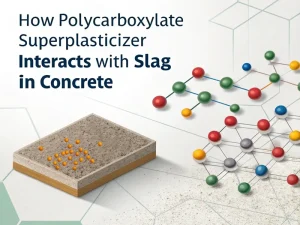Blog

Admixtures are special chemicals or materials added to concrete during the mixing process to alter its properties in a fresh or hardened state. The use of admixture has completely changed the modern construction industry, making structures stronger, more durable, and more adaptable to various environmental conditions.
Types: Ordinary (lignosulfonate), mid-range, and high-end (polycarboxylate superplasticizer).
Function: Their main function is to reduce the amount of water required in concrete or mortar mixtures while maintaining the desired consistency. By lowering the water-cement ratio and reducing water consumption by 5-40%, the strength and durability of concrete can be enhanced.
Application: High-performance concrete (HPC), self-compacting concrete (SCC).
Type: Hydroxycarboxylic acid, sugar.
Function: Used to delay the setting time of cementitious materials. This is particularly useful for setting a delay time (2-6 hours) in hot weather conditions or when involving long-distance transportation of concrete.
Application: Large concrete slabs, large volume concrete.
Types: Calcium chloride (non-enhanced), calcium nitrate (enhanced).
Function: Accelerate the setting and hardening process of concrete or mortar with additives and accelerate early strength growth (20-30% in 24 hours). Helps concrete reach the required strength faster, shortens construction time, and ensures projects proceed as planned.
Application: Emergency maintenance, cold weather concrete pouring.
Type: Vinsol resin, synthetic detergent.
Function: Introduce microbubbles (4-7% volume) to improve freeze-thaw resistance. When water freezes and expands within the pores of concrete, bubbles provide space for expansion, preventing concrete cracking.
Application: Roads and bridges in cold climates.
Type: Fly ash, silica fume, slag, metakaolin.
Function: Improve durability, reduce hydration heat, and lower carbon footprint.
Applications: Marine structures, sustainable buildings.
To learn more, please read Types Of Mineral Admixtures>>
Shrinkage-reducing agent: Minimize cracking as much as possible (such as polypropylene fibers).
Corrosion inhibitor: protects steel bars (such as calcium nitrite).
Colorants: Aesthetic finishes (such as iron oxide pigments).
Challenge: Pump concrete to extreme heights without segregation.
Solution: Polycarboxylate superplasticizer (PCE) reduces the water-cement ratio to 0.3 while maintaining fluidity.
Case study: Burj Khalifa (Dubai) uses PCE to pump concrete to a depth of 606 meters, achieving a compressive strength of 80 megapascals.
Challenge: Saltwater corrosion and sulfate corrosion.
Solution: Mixing additives (slag+silica powder) can reduce chloride permeability by 80%.
Case study: Øresund Bridge (Denmark, Sweden) achieved a service life of 120 years using corrosion inhibitors.

Challenge: Reduce carbon dioxide emissions from cement production.
Solution: Replace 30-50% of cement with fly ash and slag to reduce 15-30% of carbon dioxide.
Case study: The Delhi Metro in India uses 40% fly ash in concrete, which can save 200000 tons of carbon dioxide annually.
Enhanced workability: Self-compacting concrete (SCC) flows into complex shapes without vibration.
Enhanced strength: Water-reducing agents can achieve ultra-low water-cement ratios (0.25-0.35), increasing strength by 40-60%.
Durability: Air-entraining agents can prevent freeze-thaw cycles; Silicon powder densifies the microstructure.
Sustainability: Promoting environmental sustainability through industrial by-products (fly ash, slag) and energy conservation.
Cost-effectiveness: Although admixtures require additional costs, they can ultimately save the cost of construction projects. By reducing the necessary amount of water, water-reducing agents can decrease the amount of cement needed, as lower water-cement ratios can achieve the same strength with less cement.
In addition, the use of retarders or accelerators can optimize construction progress and reduce labor costs and equipment rental expenses. For example, in large commercial projects, the ability to accelerate concrete solidification time can significantly speed up the construction process, thereby saving a significant amount of money.
One of the main challenges in using additives is ensuring their compatibility with other components of building materials, such as cement, aggregates, and other additives. Incompatibility can lead to adverse effects such as reduced processability, premature solidification, or decreased strength. Therefore, it is necessary to conduct thorough testing and evaluation before using new additives in the project.
Example: Lignosulfonate may delay setting when mixed with high C3A cement.
Solution: Conduct pre-testing of external additives using project-specific materials.
Accurate dosage control of additives is crucial. Incorrect dosage may not achieve the expected effect or, in some cases, have a negative impact on the performance of building materials. For example, too much rapid setting agent can cause the concrete to set too quickly, making it unable to work. At the same time, too much retarder can delay the setting time to an unacceptable level.
Consequence: Segregation, excessive bleeding, or flash set.
Prevention: Strict dosage control (such as automatic dispensers) and compatibility testing.
Self-healing concrete: Microcapsules release epoxy resin or bacteria to seal cracks.
Temperature-responsive admixture: Adjust viscosity according to environmental conditions.
Admixtures are essential for building resilient, efficient, and sustainable infrastructure. By selecting the appropriate type – whether it’s high-efficiency water reducers for skyscrapers or corrosion inhibitors for marine environments – engineers can optimize performance while addressing environmental and economic challenges.
The future development of intelligent and bio-based additives is expected to revolutionize the industry further.

How Polycarboxylate Polyether Monomer Affect Concrete Performance
Blog How Polycarboxylate

How Polycarboxylate Superplasticizer Interacts With Slag In Concrete
Blog How Polycarboxylate